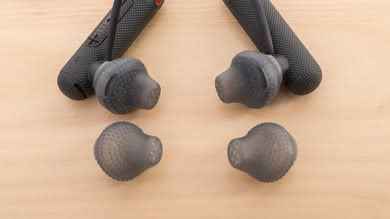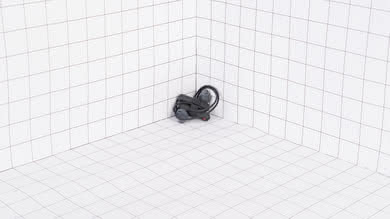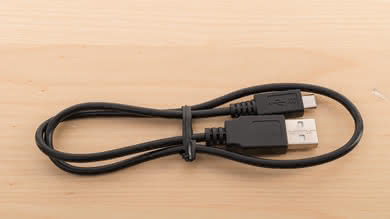Our Verdict
Mediocre for mixed usage. The Sony WI-SP500 have a unique earbud design that will work for some but unfortunately, causes a lot of issues for most use cases. The earbud fit does not isolate well in noisy conditions, which makes these headphones a poor choice for commute and travel despite their compact design. They also do not come with many tip sizes or stability fins, so they won't be the most stable headphones for sports either, which is their intended use case. They sound poorly balanced mostly due to the poor seal they create within your ears, and they have poor latency not suitable for watching movies or gaming. The seal issues also make them sound inconsistent from user to user. On the upside, they have a decent, if a little-cramped, control scheme and they are relatively comfortable to wear for long listening sessions.
- Comfortable earbud fit.
- Low leakage.
- Inconsistent and bass-light sound.
- Poor noise isolation, by design.
- Not stable enough for strenuous sports.
- Bass and treble delivery varies significantly across users.
Mediocre-at-best for neutral listening. These headphones have a somewhat decent mid-range and good reproduction of high frequencies that doesn't sound too sharp or piercing, unlike some of the other in-ears we've tested. Unfortunately, they have a terrible bass performance and poor consistency due to their unique earbud fit that is difficult to achieve a good seal. They will sound different from user to user, and since they have small earbuds, they cannot produce the soundstage of big open-back headphones, which will not be ideal for more neutral listeners. They are barely passable for casual listening, but their inconsistent sound quality and poor bass will be disappointing for most.
Mediocre for commute and travel. They're compact and comfortable but have weak noise isolation which won't be ideal for the loud environments involved in commuting.
Decent for sports. They have a comfortable earbud fit and a decent control scheme. They're also compact and easy to carry around on your person but unfortunately, they do not have the most stable fit for running and working out. They do not come with many tip sizes for different ears and no stability fins making them a less than optimal choice for sports, which is their intended use case.
Average for office use. They do not block enough noise to be the best option for a noisy office environment. On the upside they do not leak too much to you can play your music at slightly higher volumes to mask some of the ambient noise. They're also decently comfortable to wear for long listening sessions.
Below-average for gaming. They have a mediocre microphone, and too much latency to be suitable for gaming.
Changelog
- Updated Nov 21, 2019: Converted to Test Bench 1.3.1.
- Updated Nov 21, 2019: Converted to Test Bench 1.3.
- Updated Sep 07, 2018: Review published.
- Updated Sep 06, 2018: We've purchased the product and are waiting for it to arrive in our lab.
Check Price
Popular Headphones Comparisons

The Sony WI-SP500 are somewhat decent mixed-usage headphones and an above-average sports headset, although they are not as stable as most of the sports-oriented headsets we've tested. They have an earbud design that's comfortable to wear but does not come with many tip sizes or stability fins which makes them a bit of a hassle to wear when running and working out since they will often slip out of your ears. They also have a poorly balanced sound that lacks a lot of bass, mostly due to their slightly awkward fit and poor seal they create within your ears. On the upside, they are fairly well built, and the slightly open design of the earbuds allows outdoor runners to monitor their surroundings for traffic. Unfortunately, they are not the best headphones for sports, especially when compared to some of the models below. See our recommendations for the best earbuds for bass, the best wireless headphones under $100, and the best budget earbuds.
The Jaybird Freedom 2 are much better sports headphones than the Sony WI-SP500. The Jaybirds have a better, more consistent sound quality that you can also customize via their app. They isolate better in noisy conditions, and their semi earbud fit is more comfortable and stable than that of the Sony. On the other hand, the SP500 last a longer on a single charge at seven hours compared to four, although the Jaybird do come with an additional four hours stored in the charging clip. The Sonys can also pair via NFC, which makes them slightly easier to connect to mobile devices.
The Anker SoundBuds Curve 2017 are much better sports headphones than the Sony WI-SP500 Wireless. The Anker offer a much better value for your money, thanks to their better sound quality, more comfortable and stable fit, and their long battery life. On the other hand, the Sony have NFC pairing and a slightly better wireless range. The Anker are the better choice for sports and most use cases, especially in the budget range.
The Plantronics BackBeat Fit are slightly better sports headphones than the Sony WI-SP500 Wireless, but they both have seal issues that negatively affect their sound quality. The Plantronics have a much better build quality and a more durable and sweat-proof design. They're also a lot more stable for the gym and will stay on your ears no matter the physical activity, thanks to the ear-hooks. On the upside, the Sony have a better control scheme that's a little easier to use than that of the Plantronics, although not by much. They also have a slightly longer battery life and are a little bit more comfortable to wear for some people.
The JBL Endurance Sprint are a much more versatile sports headphone than the Sony WI-SP500. The JBL have a better isolating fit that will block more ambient noise in loud environments. They have stable ear hooks and a better, more durable, and water-resistant design than the SP500. The JBL also last longer on a single charge and sound much better, although they may not get very loud. On the other hand, the Sonys are bit more comfortable than the JBL. They also have NFC pairing which makes them easy to connect to mobile devices.
Test Results
The Sony WI-SP500 have a unique earbud design that will work for some but not for everyone. They have long cylindrical earbuds with tips that do not go into the ear canal as deeply as most in-ears. The controls are also cleverly laid out on the buds and not on a separate in-line remote, which keeps the audio cable simple and unobtrusive, unlike some of the other wireless in-ears we've reviewed like the Sony WI-C300 and Skullcandy Jib. They look decently well-made and come in a couple of other color schemes that stand out a bit more than the Dark Gray/Black color we've reviewed. However, the unique shape of the buds protrude out of your ears quite a bit and may not be for everyone.
The Sony WI-SP500 are slightly more comfortable than typical in-ears. They come with earbud tips that do not enter the ear canal as deeply as more common in-ears, which most will prefer although this means that they also do not create the best seal. Unfortunately, the unique shape of the buds means they may not be as practical for some use cases, like watching movies in bed and being able to lie down on your side, unlike the really small earbuds of the Jaybird Freedom. They also only come with two tip sizes, which means they won't have the perfect fit for all users, but on the upside, since the tips are similar to earbuds, they are much more comfortable to wear for long listening sessions than regular in-ears.
The Sony WI-SP500 have a slightly cramped button layout but provide all the essential functions for a Bluetooth headset. They have a volume rocker on the underside of the right earbud that also controls track skipping if you press and hold the + or - volume buttons. They also have a power button on the bottom of the right bud that doubles as the play/pause and call management button. It's a simple and functional control scheme but just feels a bit cramped and does not have the best tactile feedback. Also, the layout takes a bit of time to get used to since it's a bit different from typical wireless in-ears with an in-line remote.
The Sony WI-SP500, like most in-ears and earbuds like the Plantronics BackBeat Fit, are very breathable headphones. The unorthodox earbud design and tips, trap slightly more heat within the notch of your ear when compared to typical in-ear designs, but it's very negligible and will not be noticeable under most circumstances, even during more intense physical activity.
The Sony SP500 are bit larger than typical in-ears but are still very portable headphones that will easily fit into your pockets. Unfortunately, they do not come with a case or pouch to make them easier to carry around in your bag, which is slightly disappointing.
The Sony WI-SP500 have a decent build quality that feels durable enough for most use cases but has a relatively thin and flimsy cable. The long cylindrical earbuds feel dense and sturdy enough to handle multiple accidental drops without getting damaged. They also have an IPX4 splash-proof rating which is decent but won't be as sweat proof as some of the more sports-oriented headphones we've tested like the Anker SoundCore Spirit X or the JBL Endurance Sprint. Unfortunately, the cable feels a little cheaper than the rest of the design. It's not flat, braided or heavily rubberized like some of the other more premium in-ears we've tested. The cable may not be as durable as the rest of the design but overall, they should last you a while when used casually.
The Sony WI-SP500 are moderately stable. They're lightweight, and wireless but unfortunately, do not come with many tip sizes and do not have any stability fins to prevent them from falling out of your ears when exercising or doing more strenuous physical activities. They should be stable enough for jogging and most casual use cases, but the lack of tip options or an ear-hook design, like the JBL Endurance Sprint or the Anker Soundcore Spirit X, means they will not be the ideal headphones for sports.
The frequency response consistency is quite poor. This is mainly due to their unusual earbud design, which makes their fit and placement quite inconsistent across multiple re-seats. In the bass and treble ranges, we measured more than 9dB of deviation in delivery depending on the placement of the headphones on our dummy head. However, depending on the size and shape of your ears, you may be able to achieve more consistent results with these earbuds.
The bass range performance of the WI-SP500 is mediocre-at-best. LFE (low-frequency extension) is at 58Hz, which is below-average. Low-bass, responsible for the thump and rumble common to bass-heavy music and sound effects is lacking by 10dB. Mid-bass, responsible for the body of bass guitars and the punch of kick drums is balanced, but with a tilt favoring higher frequencies. High-bass, responsible for warmth is overemphasized by more than 5dB. Overall, the bass of these headphones lacks sub-bass, and is noticeably boomy and muddy. It should also be noted that bass delivery of these earbuds varies significantly across users and re-seats, and the measurements shown here may not match what you hear.
The mid-range is mediocre. The overall response is quite even and flat but consistently overemphasized by more than 5dB. This makes the mid-range of these headphones quite prominent and overpowering, which results in a boxy and forward sound.
The treble range performance of the Sony WI-SP500 is very good. The response throughout the range is quite even but slightly hyped. This results in a detailed and clear reproduction of vocals, lead instruments, and cymbals, but their overall sound profile is on the bright side. Also, their treble delivery varies noticeably across users. The response here represents the average response and your experience may vary.
The imaging performance of the Sony WI-SP500 is average-at-best. Weighted group delay is 0.18, which is low and within good limits. The GD graph also shows that besides the fluctuations below 20Hz the rest of the group delay is below the audibility threshold. The sub-20Hz fluctuations won't be noticeable to most people, and therefore the bass of these headphones will be tight and fast, and their treble transparent. However, the L/R drivers of our test unit didn't measure as very well-matched, which is partly due to their unusual earbud design, making their fit and placement quite inconsistent. Therefore, the placement and localization of objects (voices, instruments, video game effects), may not be very accurate and precise.
The Sony WI-SP500 have a poor soundstage. This is mainly due to their lack of interaction with the pinna, which is a key factor in giving the sense of a large and in-front soundstage. However, because of their open design, they tend to have a more open and spacious soundstage than closed-back headphones.
The Sony WI-SP500 have a poor isolation. These headphones have open earbuds and therefore don't provide any isolation in the bass range. This means they will let in all the low rumbling noises like the sound of an airplane or bus engine. In the mid-range, important for blocking out speech, they isolate by about 3dB, which is quite inadequate. In the treble range, occupied by sharp sounds like S and Ts, they achieve 17dB of isolation, which is decent.
The leakage performance is great. These headphones don't leak in the bass and mid-range, meaning their leakage will be quite thin sounding. The significant portion of their leakage is spread in a narrow band around 6KHz. The overall level of their leakage is quite low too. With the music at 100dB SPL, their leakage at 1 foot away averages at 31dB SPL and peaks at 48dB SPL, which is just below the noise floor of an average office.
The Sony WI-SP500 have a mediocre microphone. In quiet environments, speech recorded or transmitted with this mic will sound relatively thin, and noticeably lacking in detail. However, it may also sound a bit sharp and piercing in certain frequency ranges. In noisy situations, they struggle to fully separate speech from background noise even in moderately loud situations, like a busy street.
The microphone of the SP500 has a mediocre recording quality. The LFE (low-frequency extension) of 233Hz results in a recorded/transmitted speech that is relatively thin. The HFE (high-frequency extension) of 3.6KHz means speech will lack detail, however, the significant peak around 2KHz could make the sound of this microphone quite piercing.
The noise handling of the WI-SP500's microphone is mediocre. In our SpNR test, it achieved a speech-to-noise ratio of 11dB. This means they are best suited for quiet environments, as they may struggle to fully separate speech from ambient noise even in moderately loud places.
These headphones have a somewhat decent 7-hour battery life but do not have a lot of power saving features. You can't use them while they are charging, they have no auto-off feature once connected to a Bluetooth source, and no passive playback since they are Bluetooth-only headphones. On the upside, they charge decently quickly at 1.9 hours.
The Sony WI-SP500 headphones do not come with a compatible app for added customization options
These headphones do not have multi-device pairing but do support NFC. Their hold-to-pair procedure is also not too difficult to use compared to some of the other Bluetooth headphones we've tested.
These headphones have quite a bit of latency which will be noticeable when watching videos. It's a bit more than typical Bluetooth headphones and will not be ideal for latency-sensitive use cases.
The Sony SP500 have no wired option. If you want a good sounding wired in-ear, then check the 1More Triple Driver In-Ear.
These headphones do not have a dock. If you want a headphone that's versatile and has a dock, try the SteelSeries Arctis 7. However, they won't be as portable or as suitable for sports as the SP500.



























































































